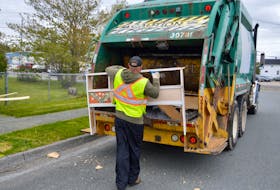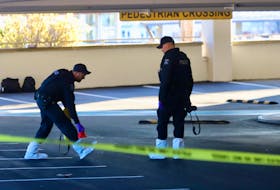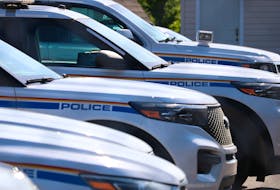Scott Thomas was appalled to hear the owner of the Alberta trucking company that employed Jaskirat Singh Sidhu was hit with a fine of just $5,000.
“To me that’s disgusting. That’s a slap in the face,” said Thomas, whose son Evan was killed when Sidhu’s semi slammed into the bus carrying the Humboldt Broncos.
In Thomas’s view, it proves there’s still work ahead to strengthen highway safety in Canada. He wants harsher penalties for trucking companies that put public safety at risk.
But he applauds a long list of other actions, in Saskatchewan and across Canada, inspired by the tragedy or accelerated by it.
Along with other families, Thomas has called for change in three broad areas. He wanted mandatory driver training, seatbelts on all coaches and improvements to highway intersections.
One year after the tragedy, Thomas has seen progress on all three fronts. He applauds the work so far, but sees a need for more.
“Any one of these things are all baby steps to the bigger picture: to try and make anytime we go on a road safer for every Canadian,” said Thomas.
Driver training
Susan Ewart, executive director of the Saskatchewan Trucking Association, agrees with Thomas.
The work has started, but it isn’t done.
“It’s unfortunate that a very bad tragedy had to happen in order for some very positive changes to happen within the trucking industry,” she said.
Ewart said Thomas is right that penalties need to be stepped up, to hold owners who “cheat” accountable.
“If you are not following the rules, you should be punished, and that was probably not as punishing of a fine as it could have been,” she said.
But Ewart stressed how safety has always been “paramount” for the industry. So much so, she said, that they pushed for mandatory training long before the tragedy.
She said the government came out in favour of standardized training beforehand, but only opted for a mandatory system after the crash.
Joe Hargrave, minister responsible for Saskatchewan Government Insurance (SGI), believes the system Saskatchewan has ended up with — 121.5 hours of mandatory training for Class 1 commercial drivers — would look the same today with or without the Broncos tragedy.
But he said the events of April 6, 2018, drove home the need for action, in Saskatchewan and elsewhere.
“It made everybody a little more aware and said, yes, we have to do something,” he said. “Not only in Western Canada, but in all of Canada, North America. Everybody was starting to look at it.”
Now, all three Prairie provinces either require mandatory training for semi drivers or have announced plans to do so. Hargrave said that’s essential, since so many trucks pass between provincial boundaries.
Sidhu himself came from Alberta. He blamed the tragedy on his “lack of experience” during his sentencing hearing in February.
Hargrave hopes provinces without mandatory training — like British Columbia — will follow the example set on the Prairies. He also expects to see efforts from the federal government to roll out a national standard, and is awaiting news in the New Year.
But Hargrave too sees tasks ahead. SGI will wrap up consultations with farmers over whether they should continue to be exempted from the 121.5-hour standard.
He also sees a need to ensure knowledge of the dangers represented by semis is widely known across Saskatchewan. He said there’s an ongoing review of standard Class 5 licences to ensure people know what to expect.
Intersection safety
According to Ewart, the thought of the horror at the intersection of Highways 35 and 335 has stuck with truck drivers.
She’s heard from companies that use it as a cautionary tale.
“You know, just doing that team sort of huddle … think about what happened in Humboldt when you get in behind the driver’s seat,” she recounted.
“It touched really close to a lot of our member companies.”
She agreed that it’s likely front of mind for many drivers as they travel Saskatchewan’s roads, approaching its innumerable intersections.
The collision has also been on the minds of staff in the Ministry of Highways and Infrastructure, as they review intersections across the province to see how they can be made safer.
Spokesman Doug Wakabayashi said the tragedy created “a heightened focused on things like intersection safety.”
Wakabayashi said the ministry has spent $750,000 since the collision assessing and clearing sight triangles.
He said that amount of spending is “significantly higher” than in previous years.
Going forward, the ministry will be able to draw from a $65 million pot of funding for highway safety improvements committed in last month’s budget over a five-year period.
Finance Minister Donna Harpauer said that was already in the works, but she suggested the public profile of the Broncos crash may have “accelerated” the process.
The intersection of highways 35 and 335, the site of the tragedy last April, will be one of the first.
Wakabayashi said the ministry has already begun making improvements there. He said all of the short-term recommendations of an engineering report done after the collision are either fulfilled or will be by the end of this year’s construction season.
Other recommendations are on the way too, he said, including efforts to widen the shoulders.
Seatbelts
Last month, Chief Coroner Clive Weighill laid out seven recommendations that he thought could help prevent another tragedy on the scale of what struck the Humboldt Broncos.
He noted many of the players who died or were injured in the collision were thrown from the bus, and speculated that seatbelts may have protected them.
He recommended Transport Canada require all passenger coaches — old or new — to come equipped with seatbelts.
Transport Canada has made changes, but they don’t reach as wide as Weighill would have liked. Starting in 2020, all new medium and large coaches will need to be built with seatbelts for passengers.

SGI says the province will comply when the new rules take effect and “work with the federal government to implement any changes as needed.”
Currently, provincial law requires passengers to wear seatbelts on vehicles that come equipped with them. That’s true of “the vast majority” of coaches built after 2016, according to SGI.
But just because the law is there doesn’t mean it will be followed. That’s up to the adults who ride with junior hockey players on their trips to game day.
Bill Chow, president of the Saskatchewan Junior Hockey Association (SJHL), acknowledged that players may be unwilling to wear seatbelts as they fraternize with teammates or try to get some sleep on a long journey.
Whatever policy the SJHL makes, he said he can’t be on every bus to make sure its followed.
“It is a challenge,” he said. “But again, it’s an education process.”
Chow said the SJHL did make a policy change on the issue, and decided to send out an email to teams. It told them, in his words, that “on chartered buses that have seatbelts, the seatbelts should be used accordingly.”
But Chow said there’s no penalties for teams that don’t comply. He also noted that some teams may be unwilling to break contracts with coach companies that provide buses without seatbelts.
“Some of the teams have contracts with coaches because then that way they get a better mileage rate,” he explained. “For them to be, for lack of a better term, breaking those contracts at this point in time, I don’t think that’s fair to put that demand on them at this time.”
Chow further noted there has been no specific direction to teams on which coach lines they should use.
Hargrave said he has heard from coaches and managers who take the matter seriously and ensure their players are buckled in.
“I applaud the managers of those teams and the schools, whoever is booking the coach,” he said, encouraging all to ask specifically for seatbelt-equipped coaches.
Health care
The Emergency Room at Saskatoon’s Royal University hospital was “organized chaos” as severely injured patients began to come in for treatment on the night of the crash.
That’s what Dr. Hassan Masri told the Toronto Star the next day. He said there wasn’t a single hiccup that night, after a “Code Orange” was called for a mass casualty incident.
The Saskatchewan Health Authority (SHA) nonetheless launched a review of its policies and procedures for responding to mass casualty incidents following the tragedy. It does so after every such incident, according to spokesman Doug Dahl.
He said the SHA is creating a departmental Code Orange checklist for its acute care sites. It has already come to St. Paul’s Hospital and Royal University Hospital in Saskatoon, and is expected to come to Saskatoon City Hospital this spring.
“They are meant to provide detailed information of what the department is meant to be doing during a Code Orange,” Dahl explained.
A checklist template has also been shared with hospitals in Nipawin, Regina and a few other areas. Work is also ongoing to develop a health emergency management provincial team, which will focus on standardizing codes, including Code Orange.
An incident command checklist is also in the works, as is a leadership contact list to support a provincial on-call program.
While treatment immediately after the crash may have gone as smoothly as it could, given the chaotic circumstances, there was one notable — and excruciating — error in the days following.
Surviving Bronco Xavier Labelle had been mistaken for Parker Tobin, who died in the crash.
Weighill made recommendations on how to prevent a repeat of the identification mistake, including one to his own office.
The other went to the SHA, which apologized. It committed to making every effort to strengthen its policies around patient identification.
Copyright Postmedia Network Inc., 2019









